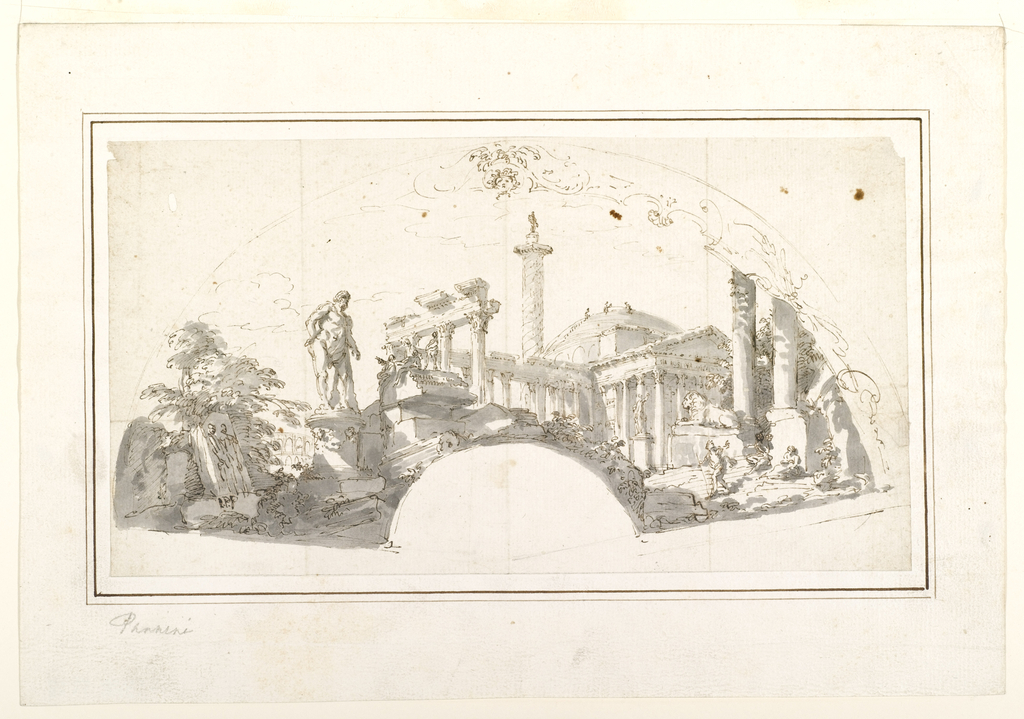There is one other image of this object. This image is in the public domain (free of copyright restrictions), and as such we offer a high-resolution image of it. See our image rights statement.
See more objects with the color silver grey dimgrey or see all the colors for this object.
Object Timeline
|
1938 |
|
|
2005 |
|
|
2014 |
|
|
2015 |
|
|
2025 |
|
Drawing, Design for a Fan: Capriccio with Roman Ruins and the Farnese Hercules, ca. 1750
This is a Drawing. It was created by Giovanni Paolo Panini. It is dated ca. 1750 and we acquired it in 1938. Its medium is pen and brown ink, brush and gray wash, graphite on cream laid paper, lined. It is a part of the Drawings, Prints, and Graphic Design department.
Putting the Fan in Fantasy
From the eighteenth century, painted fans were one of the most popular souvenirs for any grand tourist visiting Italy. In this period, fans were part of the complex network of courtly behavior and aristocratic social codes, and they were also indispensable elements for coquetry. Such fans were made with a variety of materials such as silk, lace, leather, parchment and painted paper, with the supporting structure ranging from mother of pearl, ivory, wood, and tortoiseshell.
This pen and ink drawing displays a potential design for a fan. Foliate ornaments faintly border the top edges of the fan, in the popular rococo style rather than the architectonic motifs that would later characterize neoclassical style in the second half of the eighteenth century. A fantastic and imaginary classical landscape dominates the entire face of the fan. Several iconic monuments from Rome can be identified. To the left is the Farnese Hercules on a round pedestal. Behind is a faint outline of the coliseum. Jutting vertically into the sky in the center is the Trajan’s column and directly to the right of that is the Pantheon. The ruined temple in the center may perhaps be the temple of Castor and Pollux. There is also a fountain with a Medici lion in front of the Pantheon. Various broken capitals, bases, and steles occupy the overgrown and ruinous landscape. Minute figures lounge in the shade or explore and point at monuments, mimicking the inquisitive behavior of grand tourists in Rome.
Such fantasy landscapes are called capricci, a term that derives from the Italian word, caprice. They were popularized by paintings, drawings and prints made by Giovanni Paolo Panini (to whom this design is attributed to), Giovanni Battista Piranesi, and Giovanni Battista Tiepolo that were also collected by grand tourists throughout the long eighteenth century. Around this time, French artists adopted the ruin capricci genre for their own. One such example is the painter Hubert Robert who would later be given the moniker Robert des Ruines after his penchant for painting ruins. The critic Diderot would later remark that one must ruin a palace to make it interesting, highlighting the artistic and creative potential of ruined landscapes.
Landscapes such as these reflected the acquisitive ambitions of the tourists as grand tours were glorified shopping trips in the guise of an instructive journey. Collectors would not only purchase paintings, drawings, and prints of Italy landscapes and antiquities but also purchase real antiquities as well as miniature models of the famous monuments and sculpture of Rome. In the same period, fans were actively produced and collected in France and England. Many of them featured designs after contemporary painters and engravers.
Although it is unclear whether the Cooper Hewitt design was actually realized, it is nonetheless a prime example of souvenir trade that lay at the heart of the Grand Tour. Fans in general were in fashion and in craze throughout the eighteenth century, from Paris to London. Such was the craze for fans the writer Joseph Addison’s published a satire on fans in the Spectator on June 27, 1711. This essay was written in the guise of a letter from the owner of a fan academy and Addison derided the complicated language of the fans, writing, “There is an infinite variety of motions to be made use of in the flutter of a fan. There is the angry flutter, the modest flutter, the timorous flutter, the confused flutter, the merry flutter, and the amorous flutter…I need not add, that a fan is either a prude or a coquette, according to the nature of the person that bears it.”
This object was featured in our Object of the Week series in a post titled Putting the Fan in Fantasy.
It is credited Museum purchase through gift of various donors and from Eleanor G. Hewitt Fund.
- Print, Scenes in Cinderella, Garden, Scenes 1 and 10, 1877–1935
- hand-colored lithograph on paper mounted on cardboard.
- Gift of W. H. Solle.
- 1938-61-7-a
Its dimensions are
14.1 x 26 cm (5 9/16 x 10 1/4 in.)
It is signed
Lower left in pen and gray ink: I.P.P
Cite this object as
Drawing, Design for a Fan: Capriccio with Roman Ruins and the Farnese Hercules, ca. 1750; Giovanni Paolo Panini (Italian, 1691 - 1765); Italy; pen and brown ink, brush and gray wash, graphite on cream laid paper, lined; 14.1 x 26 cm (5 9/16 x 10 1/4 in.) ; Museum purchase through gift of various donors and from Eleanor G. Hewitt Fund; 1938-88-7323
This object was previously on display as a part of the exhibition Excavating Design: 18th-century Drawings and Prints from the Permanent Collection.

